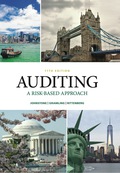
EBK AUDITING: A RISK BASED-APPROACH
11th Edition
ISBN: 9781337670203
Author: RITTENBERG
Publisher: YUZU
expand_more
expand_more
format_list_bulleted
Question
Chapter 4, Problem 20RQSC
(a)
To determine
Introduction: Auditor is appointed by the company in order to get their financial statements checked whether they are authentic or reliable for further usage by the shareholders and other users.
The merits of the actions that can be taken by the common stock purchaser and by the bank.
(b)
To determine
Introduction: Auditor is appointed by the company in order to get their financial statements checked whether they are authentic or reliable for further usage by the shareholders and other users.
The different if the client file the case using registered statement company under 1933 act.
Expert Solution & Answer
Want to see the full answer?
Check out a sample textbook solution
Students have asked these similar questions
One company might depreciate a new computer over three years while another company might depreciate the same model computer over five years...and both companies are right.
True
False
no chatgpAccumulated Depreciation will appear as a deduction within the section of the balance sheet labeled as Property, Plant and Equipment.
True
False
No ai Depreciation Expense is shown on the income statement in order to achieve accounting's matching principle.
True
False
Chapter 4 Solutions
EBK AUDITING: A RISK BASED-APPROACH
Ch. 4 - Prob. 1CYBKCh. 4 - Prob. 2CYBKCh. 4 - Prob. 3CYBKCh. 4 - Prob. 4CYBKCh. 4 - Prob. 5CYBKCh. 4 - Prob. 6CYBKCh. 4 - Prob. 7CYBKCh. 4 - Prob. 8CYBKCh. 4 - Prob. 9CYBKCh. 4 - Prob. 10CYBK
Ch. 4 - Prob. 11CYBKCh. 4 - Prob. 12CYBKCh. 4 - Prob. 1RQSCCh. 4 - Prob. 2RQSCCh. 4 - Prob. 3RQSCCh. 4 - Prob. 4RQSCCh. 4 - Prob. 5RQSCCh. 4 - Prob. 6RQSCCh. 4 - Refer to the Focus on Fraud feature “Moss Adams...Ch. 4 - Prob. 8RQSCCh. 4 - Prob. 9RQSCCh. 4 - Prob. 10RQSCCh. 4 - Prob. 11RQSCCh. 4 - Prob. 12RQSCCh. 4 - Prob. 13RQSCCh. 4 - Prob. 14RQSCCh. 4 - Prob. 15RQSCCh. 4 - Prob. 16RQSCCh. 4 - Prob. 17RQSCCh. 4 - Prob. 18RQSCCh. 4 - Prob. 19RQSCCh. 4 - Prob. 20RQSCCh. 4 - Prob. 21RQSCCh. 4 - Able Corporation decided to make a public offering...Ch. 4 - KPMG (LO 1, 2, 3) KPMG LLP served as the external...Ch. 4 - ToshIba, EY (LO 1, 2, 3) In 2015, the business...
Knowledge Booster
Similar questions
- no aiOne company might depreciate a new computer over three years while another company might depreciate the same model computer over five years...and both companies are right. True Falsearrow_forwardno ai An asset's useful life is the same as its physical life? True Falsearrow_forwardno ai Depreciation Expense reflects an allocation of an asset's original cost rather than an allocation based on the economic value that is being consumed. True Falsearrow_forward
- The purpose of depreciation is to have the balance sheet report the current value of an asset. True Falsearrow_forwardDepreciation Expense shown on a company's income statement must be the same amount as the depreciation expense on the company's income tax return. True Falsearrow_forwardDont use AI Give soln.arrow_forward
arrow_back_ios
SEE MORE QUESTIONS
arrow_forward_ios
Recommended textbooks for you
 Auditing: A Risk Based-Approach (MindTap Course L...AccountingISBN:9781337619455Author:Karla M Johnstone, Audrey A. Gramling, Larry E. RittenbergPublisher:Cengage LearningBusiness Its Legal Ethical & Global EnvironmentAccountingISBN:9781305224414Author:JENNINGSPublisher:Cengage
Auditing: A Risk Based-Approach (MindTap Course L...AccountingISBN:9781337619455Author:Karla M Johnstone, Audrey A. Gramling, Larry E. RittenbergPublisher:Cengage LearningBusiness Its Legal Ethical & Global EnvironmentAccountingISBN:9781305224414Author:JENNINGSPublisher:Cengage

Auditing: A Risk Based-Approach (MindTap Course L...
Accounting
ISBN:9781337619455
Author:Karla M Johnstone, Audrey A. Gramling, Larry E. Rittenberg
Publisher:Cengage Learning

Business Its Legal Ethical & Global Environment
Accounting
ISBN:9781305224414
Author:JENNINGS
Publisher:Cengage

